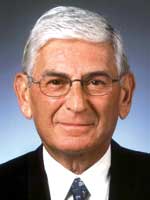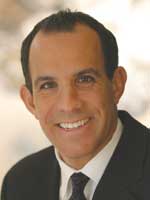Corporate Contributions to Education - Part I
This Is The First In A Series On Corporate Contributions
To Education,
Interviewing Leaders Who Have Changed The Face Of Education In Our Nation

Eli Broad:
Accelerating the
Impact of Education Philanthropy
by Joan Baum, Ph.D.
With 85 urban districts nationwide
under its purview so far, The Eli and Edythe Broad
Foundation in only its fifth year of existence has
already distinguished itself in the world of corporate
support for public education, K-12 by not just initiatives
but follow through. As Dan Katzir, Managing Director
of the Foundation has written, the challenge to philanthropists
is to “demonstrate
replicability and success in multiple locations.” Acknowledging
similar philanthropic activities by private and not-for-profit
organizations, Katzir, himself a product of public school,
eagerly notes the four main interests of giving that
he believes differentiate the Broad Foundation: (1) selecting
the district rather than an individual school as the “unit
of change”; (2) ensuring that effective practices
are widely disseminated, a move that will be augmented
shortly with the hiring of a communications director;
(3) sticking to a particular strategic focus or staying
the course after the “sexy” start up period
(Teach for America, where Katzir was COO, showed that
constancy pays off; and (4) focusing on results through
carefully monitored annual evaluations, 75 percent of
which turn on performance indicators such as standardized
assessments, GPAs, and graduation rates. Overall, the
Foundation concluded that these four areas represented
the most critical features in improving urban public
education because they centered on better governance,
including involvement of mayors and governors; management,
meaning senior leadership positions on through; and labor
relations, involving unions in a prominent way.
 The reason for concentrating
on urban schools is obvious: that’s where the need and numbers are. What isn’t
immediately apparent is the choice of the “district” for
main attention. Typically, Katzir points out, when a
particular low-performing school is turned around its
success is not duplicated in other needy schools in the
system. “Models of [education] excellence rarely
travel well,” and yet in industry and in many areas
in private, nonprofit and government sectors, “cross
fertilization” seems to work. With admirable frankness—a
remarkable achievement in the jargon-ridden education
field—the Broad Foundation clearly addresses the
failures that have plagued education philanthropy in
general. Its own initiatives proceeded only after a year
of sustained interviews, research and analysis. Central
in these efforts has been the annual three-year old Broad
Prize for Education, which awards $500,000 to the winning
district and $125,000 to four runners-up in the form
of scholarships for highschool seniors. Kaztir is delighted
to point to the “integrity” of the competition
and the inclusion on its panel of judges of important
names from outside education (Jack Welch, for example).
The selection of finalists is followed by weeklong site
visits and further data collection (including grades,
honors classes, kinds of courses taken, etc.) in conjunction
with “education partners” such as ETS and
The National Hispanic Scholarship Fund.
The reason for concentrating
on urban schools is obvious: that’s where the need and numbers are. What isn’t
immediately apparent is the choice of the “district” for
main attention. Typically, Katzir points out, when a
particular low-performing school is turned around its
success is not duplicated in other needy schools in the
system. “Models of [education] excellence rarely
travel well,” and yet in industry and in many areas
in private, nonprofit and government sectors, “cross
fertilization” seems to work. With admirable frankness—a
remarkable achievement in the jargon-ridden education
field—the Broad Foundation clearly addresses the
failures that have plagued education philanthropy in
general. Its own initiatives proceeded only after a year
of sustained interviews, research and analysis. Central
in these efforts has been the annual three-year old Broad
Prize for Education, which awards $500,000 to the winning
district and $125,000 to four runners-up in the form
of scholarships for highschool seniors. Kaztir is delighted
to point to the “integrity” of the competition
and the inclusion on its panel of judges of important
names from outside education (Jack Welch, for example).
The selection of finalists is followed by weeklong site
visits and further data collection (including grades,
honors classes, kinds of courses taken, etc.) in conjunction
with “education partners” such as ETS and
The National Hispanic Scholarship Fund.
An essential consideration
of the Broad Prizes, Katzir emphasizes, is the criterion
of awarding the grants to the districts that make the
most gains. That means that judgment is based on multiple
performances and that the change from start to finish
line must be “dramatic.” A
high-performing school that improves somewhat is less
significant in this calculus than a low-performing school
that evidences great gains from freshman to senior year.
Eli and Edythe Broad, Katzir are living donors who expect
a return on their intellectual and capital investment.
The Fund is their legacy and Katzir says, and they mean
business in every sense of the word.#
For more information visit www.broadfoundation.org.
